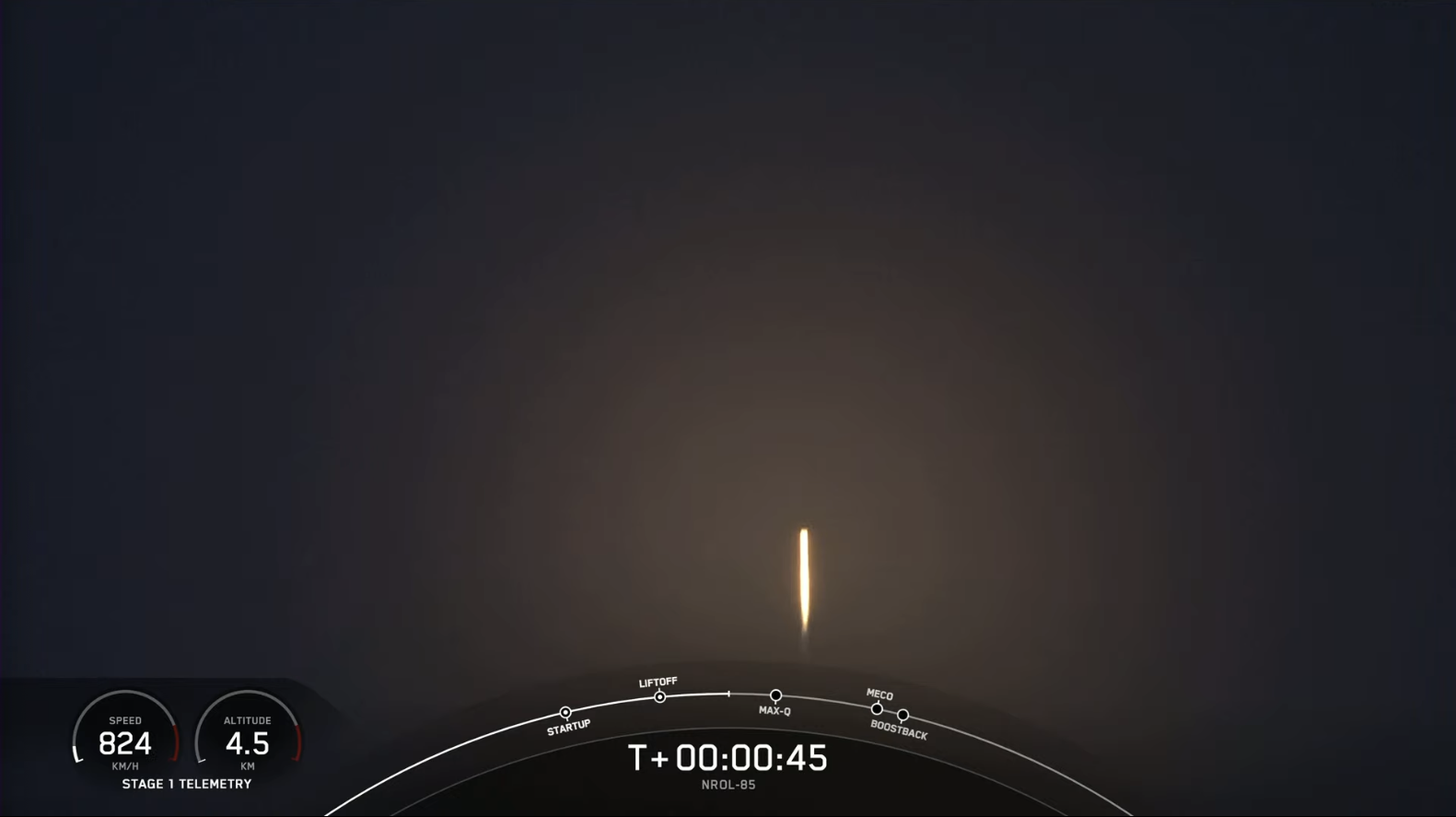
A previously-flown Falcon 9 core successfully delivered a classified payload to orbit on behalf of the National Reconnaissance Office (NRO), early Easter Sunday, with the spectacular 6:13 a.m. PDT launch of NROL-85 from Vandenberg Space Force Base, Calif. Liftoff of the B1071 core—which previously supported February’s NROL-87 mission—came from storied Space Launch Complex (SLC)-4E at the mountain-ringed West Coast launch site.
Eight minutes later, B1071 pirouetted back home to alight on solid ground at Landing Zone (LZ)-4. It is speculated that the NROL-85 payload may be a pair of low-orbiting Naval Ocean Surveillance Satellites (NOSS), dedicated to Signals Intelligence (SIGINT) and codenamed “Intruder”.
“We launched our second National Security Space Launch SpaceX Falcon 9 from Vandenberg Space Force Base and it was superb. The integrated team, the rocket, the satellite, everything was GO and this launch went smoothly,” said Col. Robert Bongiovi, director of the Space Systems Command’s Launch Enterprise.
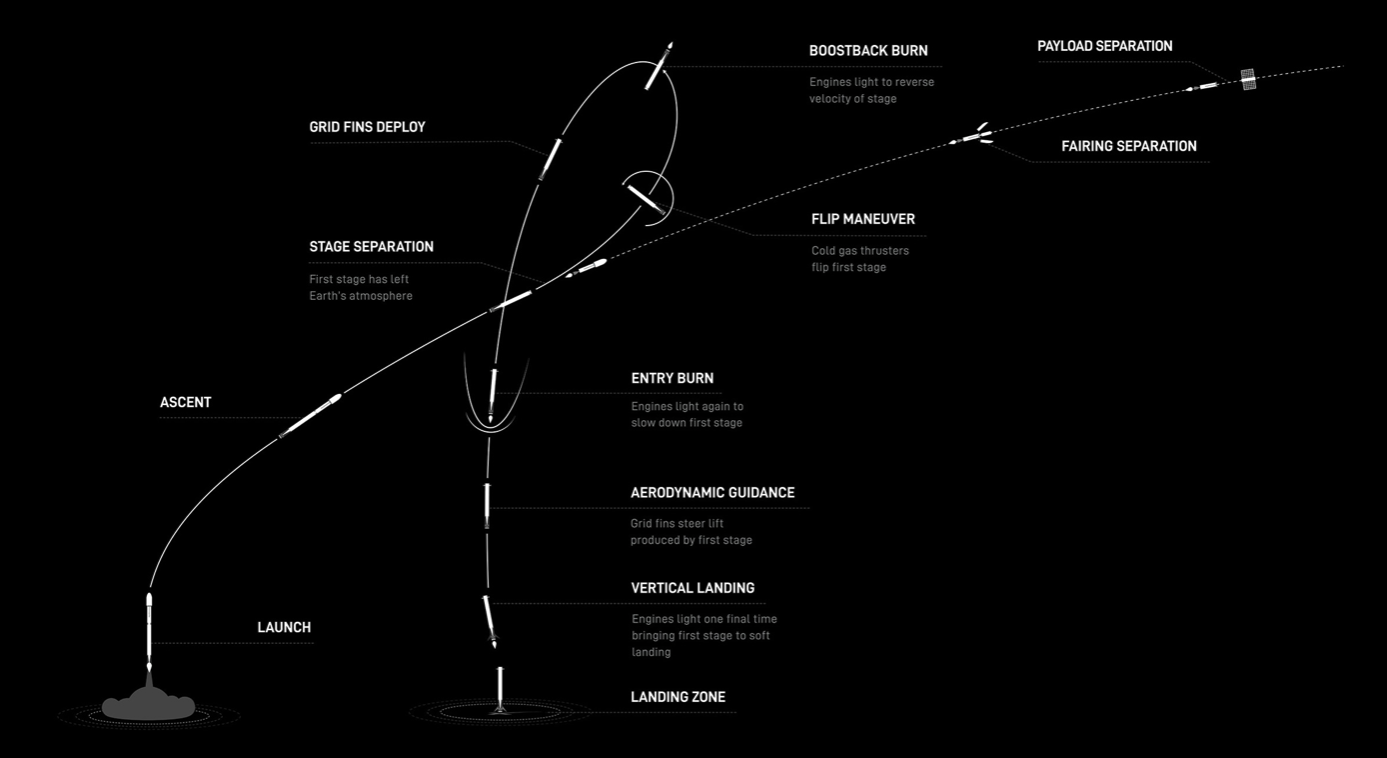
“With each launch, we add to the nation’s capabilities. Putting capability in space is what we do, and together we’re fielding the tools needed to address the threat. And we’ve built fantastic partnerships with industry and teammates such as the NRO to efficiently deliver these systems to orbit.”
Sunday’s launch occurred two days later than planned, following a pair of 24-hour slips from both Friday and Saturday. In the first case, SpaceX stressed the “additional time allows teams to complete pre-launch checkouts and data reviews”, with the NRO pointing to “technical difficulties” and highlighting that “safely launching the mission remains our highest priority”.
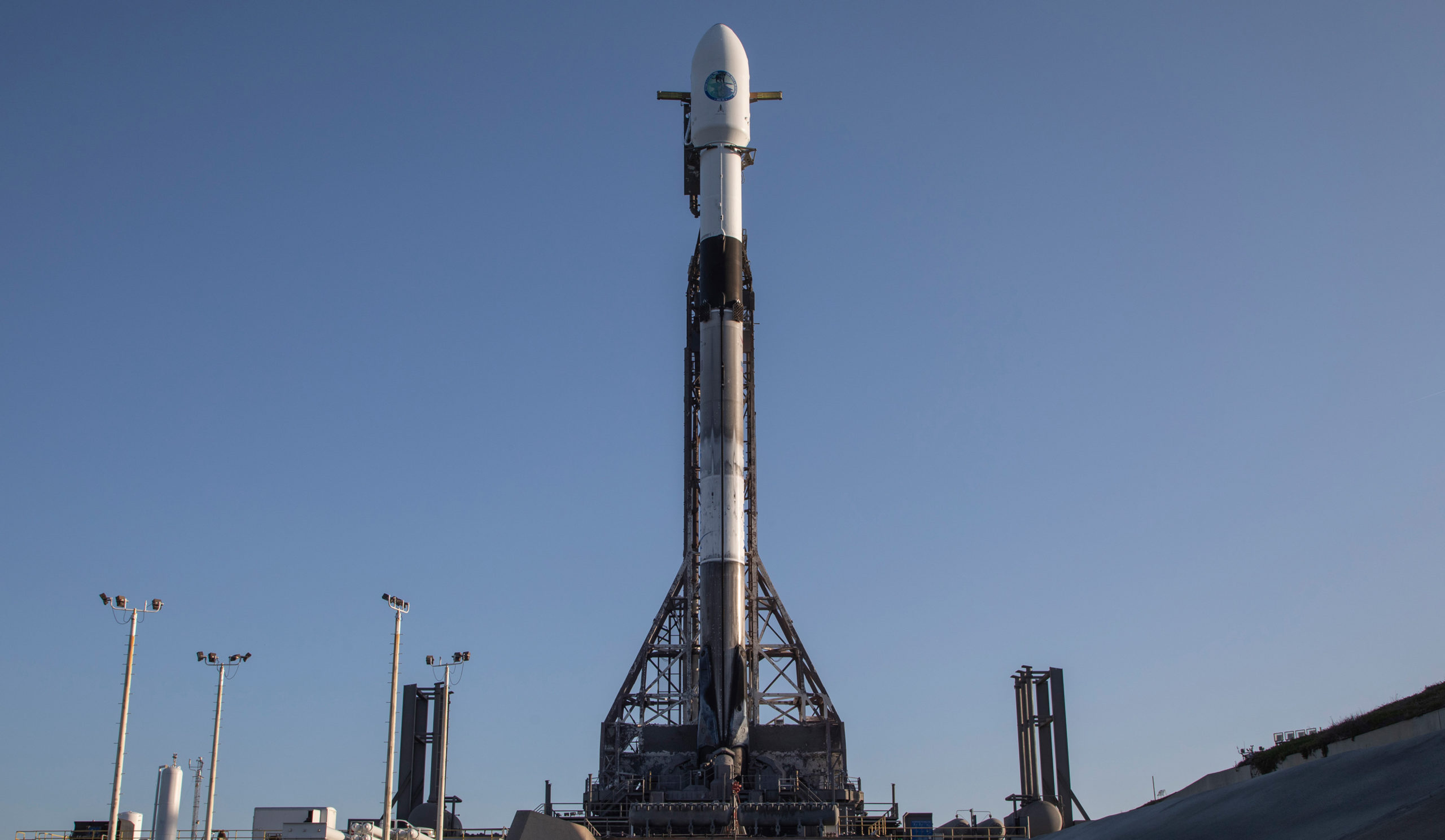
Yesterday’s second delay was reportedly due to “excessive upper-level winds forecasted”. Late Saturday evening, SpaceX shared an image of the Falcon 9 on the pad with the encouraging news that systems and weather had fallen into alignment for liftoff at dawn on Easter Sunday.
It was the third Falcon 9 launch from Vandenberg so far in 2022, coming on the heels of B1071’s maiden outing on 2 February to loft NROL-87 to orbit and a batch of 50 low-orbiting Starlink internet communications satellites on another mission just three weeks later. That already ties 2022 with the total number of Falcon 9s flown out of the West Coast in 2021 and jointly represents the highest amount of SpaceX missions from Vandenberg since 2018. With up to five more flights targeted from the West Coast, 2022 may end as Vandenberg’s most-flown year on record for the Hawthorne, Calif.-headquartered launch services organization.
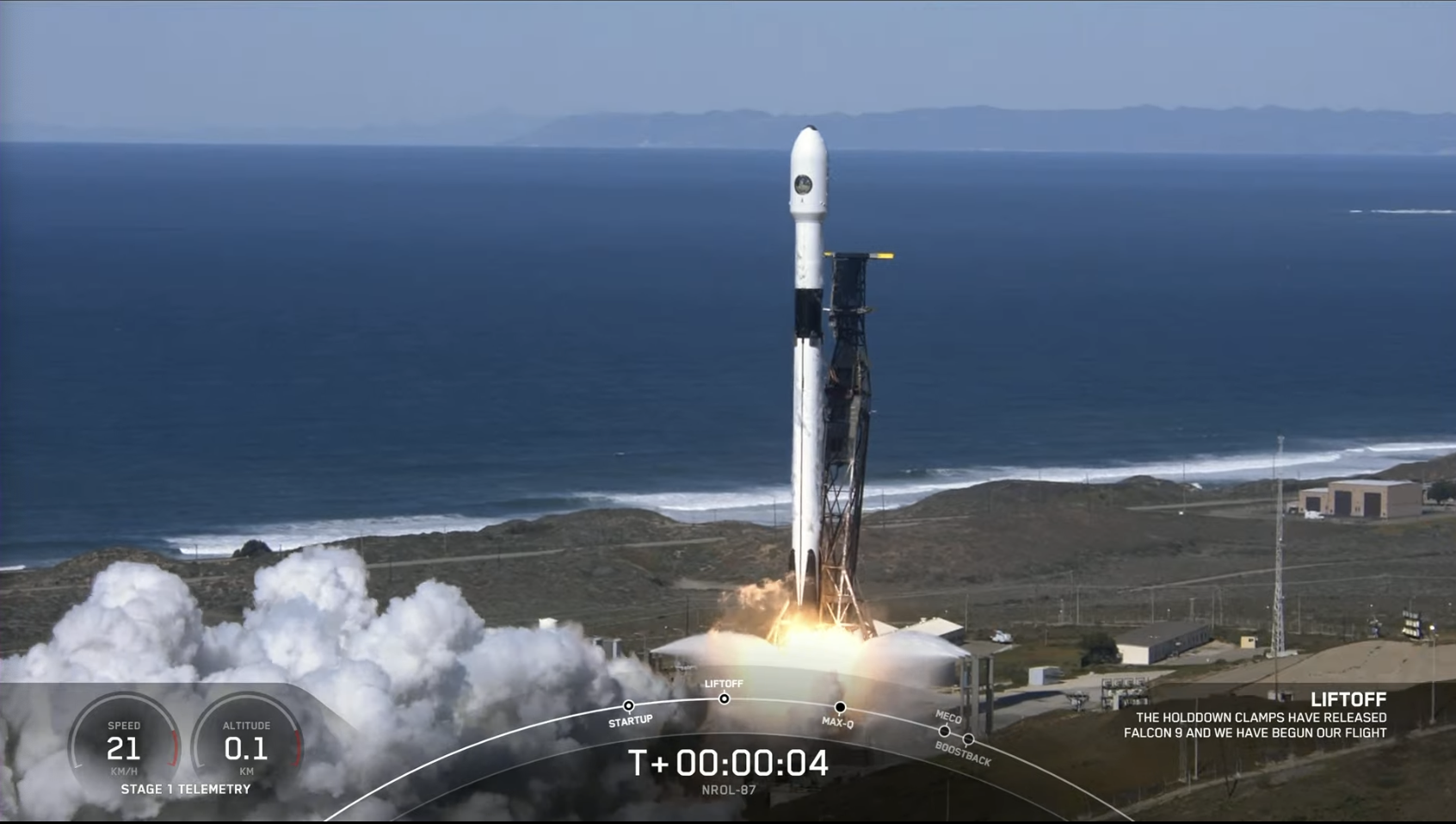
In readiness for her second classified mission, B1071 was rolled out to SLC-4E earlier this month and put through a Static Fire Test of her nine Merlin 1D+ engines on 5 April. As is customary, coverage of the NROL-85 mission was expected to end ahead of second-stage ignition and even SpaceX’s website provided data only through the landing of B1071 back at LZ-4. No details of second-stage flight—including burn duration and even the number of burns—were revealed, in accordance with the wishes of the customer.
This morning’s flight was the sixth fully classified mission undertaken by SpaceX, coming on the heels of NROL-76 in May 2017, the X-37B Orbital Test Vehicle (OTV) in September 2017, the controversial Zuma—rumored to have been lost soon after its January 2018 launch—and more recently NROL-108 in December 2020 and last February’s NROL-87. And although NROL-108 also rode a previously-flown Falcon 9 core, the back-to-back NROL-87 and NROL-85 missions make B1071 the first individual booster to have flown twice in support of NRO objectives.

With mission artwork depicting a seemingly innocent cat, mirror-imaged against a fearsome tiger, and emblazoned by the legend “Attitude is a Little Thing That Makes a Big Difference”, NROL-85’s symbology revealed little of what this payload will do. The cat, it was noted by the NRO, represents loyalty and devotion, whilst the tiger is illustrative of a determined attitude necessary to overcome challenges. Three stars on the NROL-85 patch signify guidance, protection and allegiance.
But the nature of NROL-85 remains open to conjecture. The Request for Proposals (RfP) for Evolved Expendable Launch Vehicle (EELV) services for NROL-85 was issued back in January 2018, with proposals due the following April and an expectation that the mission would take place “from the Eastern or Western Range” in Fiscal Year 2021.
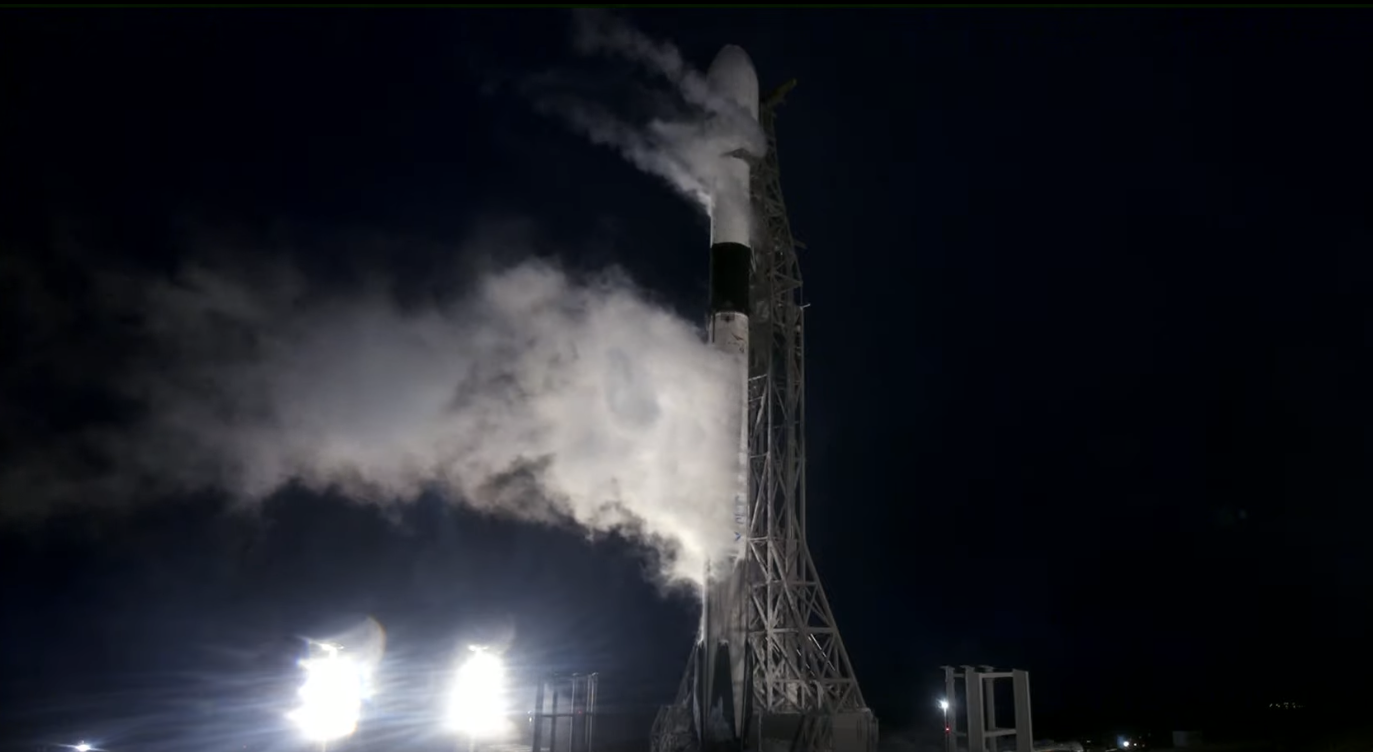
SpaceX went on to win a $297 million contract in February 2019 to launch NROL-85 and two other missions, NROL-87 and the AFSPC-44 for Air Force Space Command. At the time of the contract award, NROL-85 had been assigned an East Coast launch, but was subsequently transferred to the West Coast.
With NROL-87 having flown in February, the 8,200-pound (3,700-kilogram) AFSPC-44 payload—now known as “USSF-44” following the formation of the U.S. Space Force in December 2019—is targeted to ride a triple-barreled Falcon Heavy from historic Pad 39A at the Kennedy Space Center (KSC) in Florida as early as June.
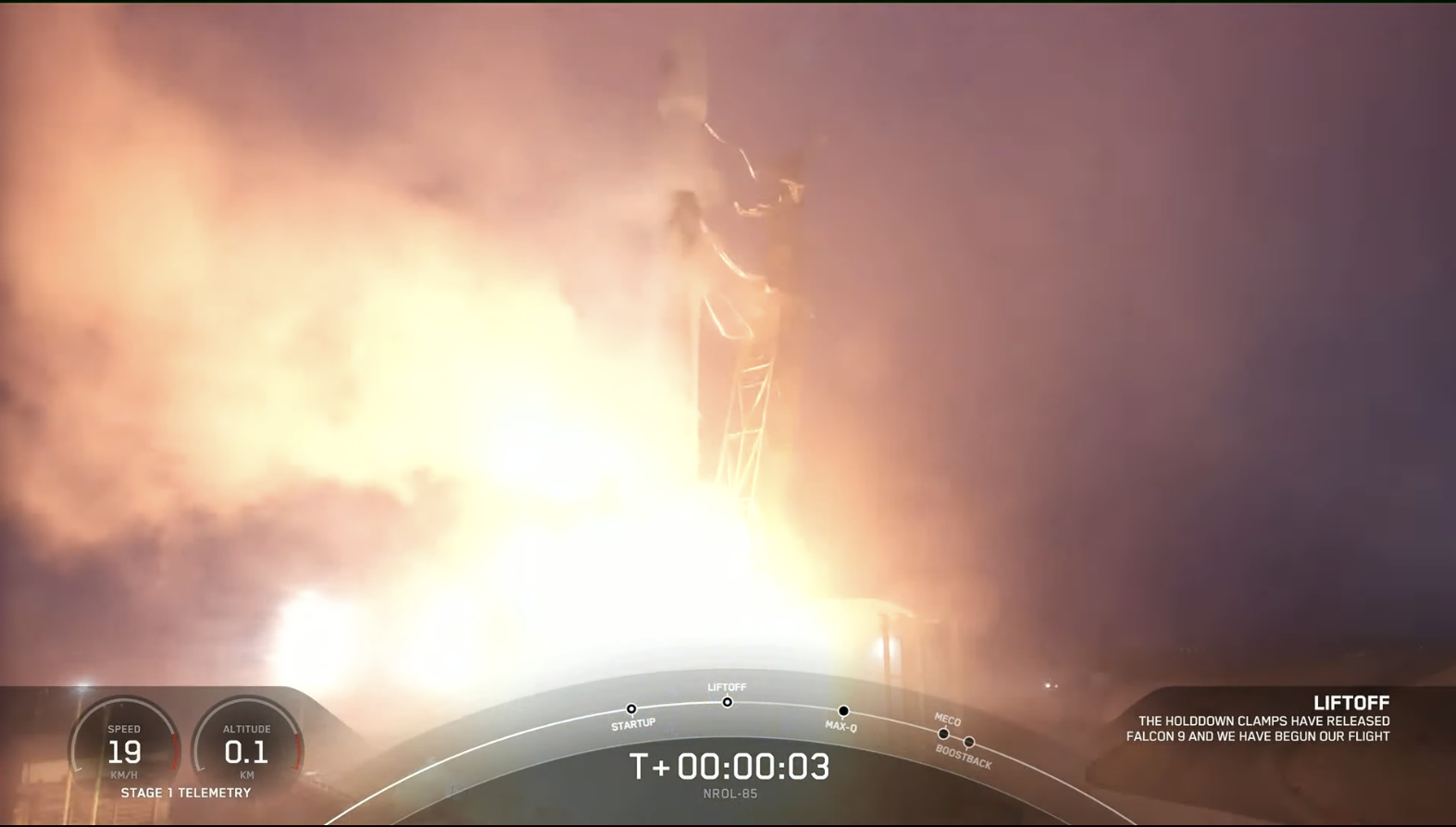
It has been suggested that NROL-85 comprises a pair of NOSS/Intruder SIGINT satellites, together weighing in the region of 14,300 pounds (6,500 kilograms). These satellites are thought to be capable of tracking shipping and aircraft via radio transmissions, establishing “fixes” by means of triangulation. Intruders are believed to operate in pairs, with each satellite maneuvering and stationkeeping relative to its twin. They may sit at altitudes of about 685 miles (1,100 kilometers), inclined 63 degrees to the equator.
Sunday morning’s launch marked the third SpaceX mission of April and B1071 rose into the pre-dawn Vandenberg murk at 6:13 a.m. PDT. Seventy seconds into flight, the booster—visible only thanks to a tongue of flame from its Merlin 1D+ engine suite—passed through a phase of maximum aerodynamic pressure, known colloquially as “Max Q”. Two and half minutes into flight, B1071 completed its job and separated from the stack. Cameras aboard the second stage stunningly captured the core as it fell away.
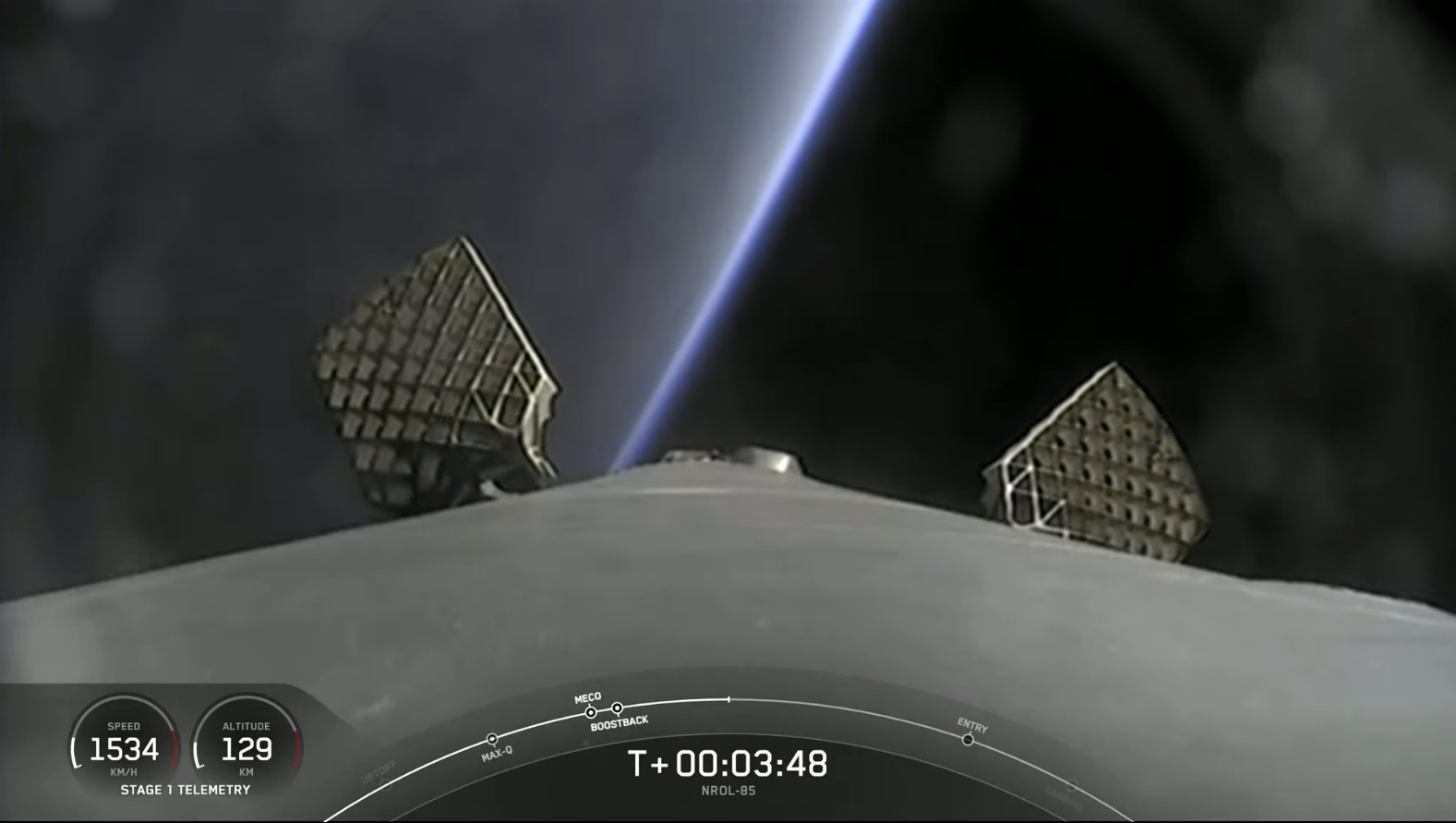
And in scenes already witnessed 13 prior times in 2022, the core began its descent smoothly back to Earth, guided with a precision not unlike a huge mechanized ballerina. But for only the fourth time this year, the Falcon 9’s landing point was not the deck of an Autonomous Spaceport Drone Ship (ASDS), situated offshore in the Atlantic or Pacific Oceans, but rather solid ground, in this case the landing pad of expansive LZ-4 at Vandenberg, located a mere 1,400 feet (425 meters) distant from SLC-4E. Touching down crisply at 6:21 a.m. PDT, it marked B1071’s second LZ-4 landing of the year and the fifth overall landing at LZ-4 since October 2018.
With three missions thus complete in April’s first half—the multi-customer Transporter-4 payload at the start of the month, followed by last week’s historic Ax-1 voyage of Dragon Endeavour and today’s NROL-85—SpaceX aims for two more flights from the Space Coast in the coming days.
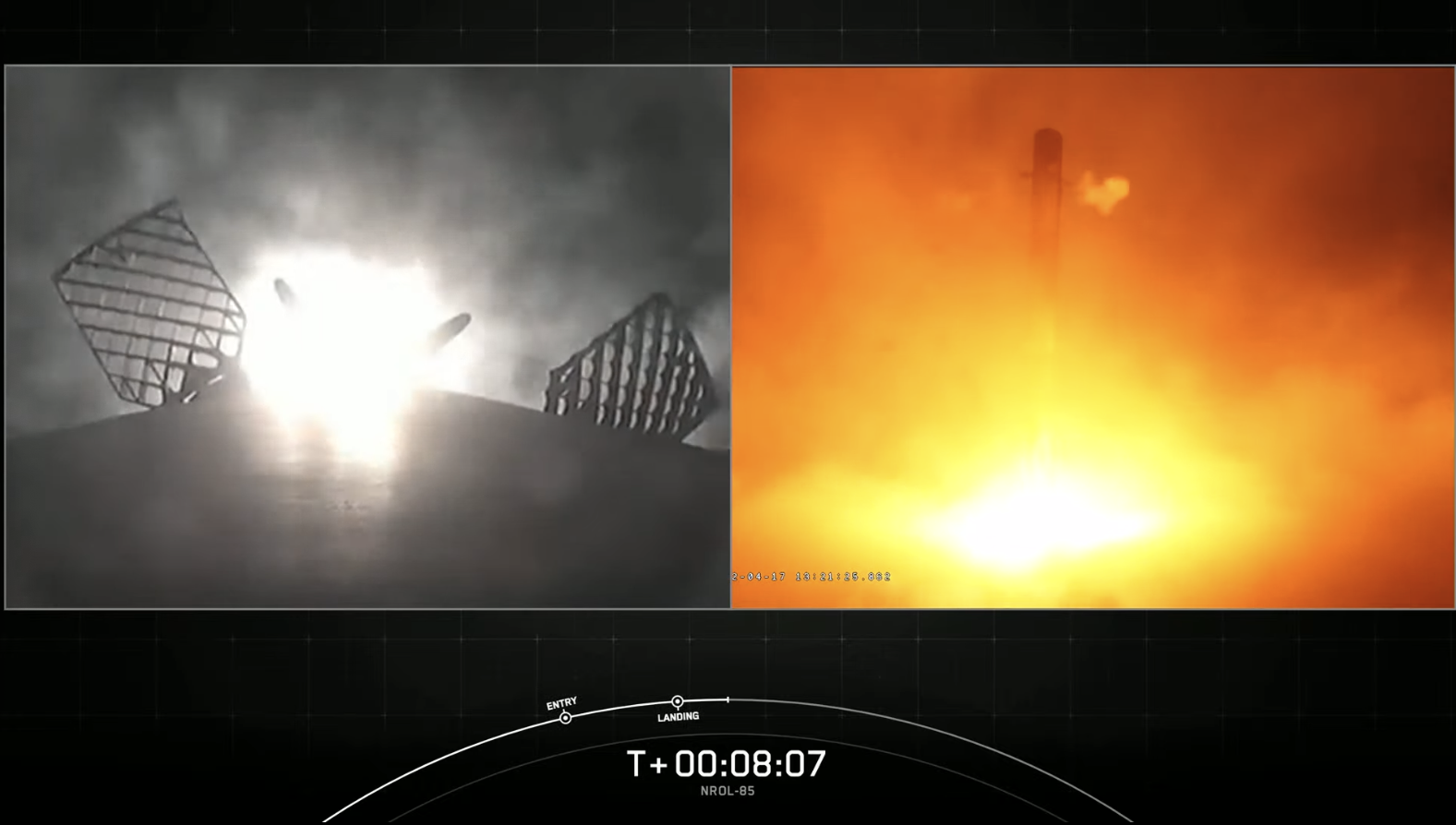
Another Falcon 9 is targeting an opening of the Eastern Range at 11:04 a.m. EDT Thursday, 21 April from storied Space Launch Complex (SLC)-40 at Cape Canaveral Space Force Station, laden with a batch of Starlink satellites. That mission will be followed by the brand-new Dragon Freedom and her U.S./Italian Crew-4 team of astronauts, bound for the International Space Station (ISS), no sooner than 5:26 a.m. EDT Saturday, 23 April.
Aboard Dragon Freedom are Commander Kjell Lindgren and Pilot Bob “Farmer” Hines, together with Mission Specialists Samantha Cristoforetti—Italy’s first woman astronaut—and Jessica Watkins. They will spend about 4.5 months aboard the ISS as members of Expedition 67, before returning to Earth in late summer or early fall.
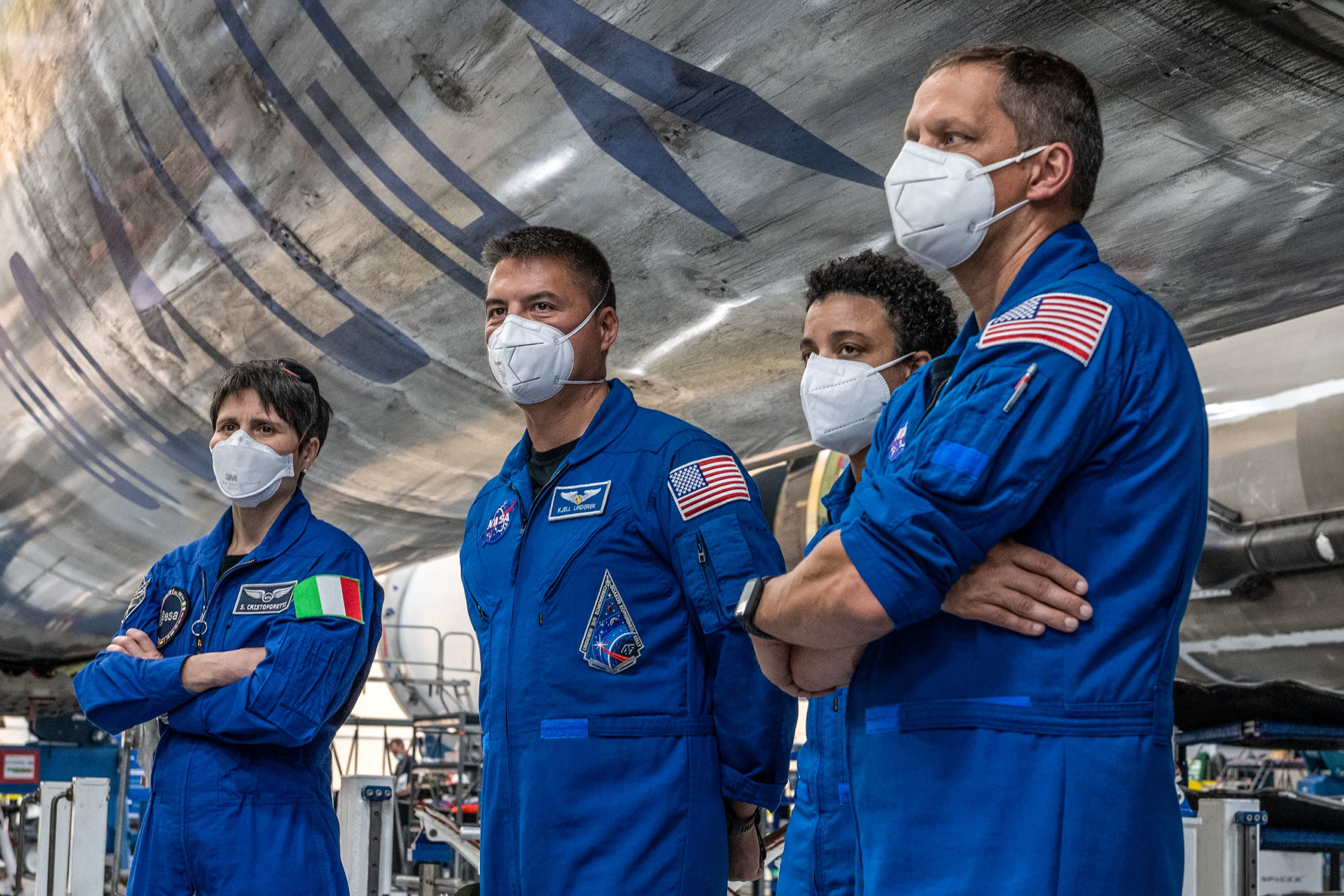
In readiness for Crew-4, Dragon Freedom was transferred from SpaceX’s processing facility at Cape Canaveral Space Force Station to Pad 39A on Saturday for installation atop her Falcon 9 booster. The rollout came less than a day after senior NASA and SpaceX leaders wrapped up a smooth Flight Readiness Review (FRR).
A successful launch next Saturday will position Dragon Freedom and her four-person crew for docking at the ISS on Sunday, for a five-day “direct handover” with the incumbent Crew-3 team. It is then expected that the Crew-3 quartet—NASA astronauts Raja Chari, Tom Marshburn and Kayla Barron, together with Germany’s Matthias Maurer—will return to Earth at month’s end, leaving Lindgren, Hines, Cristoforetti and Watkins aboard the station through the summer with their Russian crewmates Oleg Artemyev, Denis Matveev and Sergei Korsakov on Expedition 67.
FOLLOW AmericaSpace on Facebook and Twitter!
Missions » NROL »



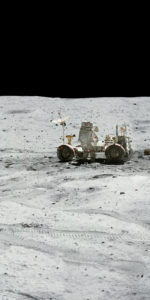
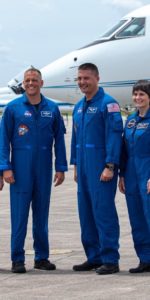
6 Comments
6 Pings & Trackbacks
Pingback:SpaceX Scores Sixth Launch of April, Achieves Turnaround Record - AmericaSpace
Pingback:25th Falcon 9 Launch of 2022 Delivers SARah-1 Surveillance Satellite to Orbit - AmericaSpace
Pingback:SpaceX Resumes Vandenberg Launches, Looks Ahead to Record-Breaking 2022 - AmericaSpace
Pingback:Late-Night SpaceX Launch Orbits Fourth Batch of Shell 3 Starlinks - AmericaSpace
Pingback:SpaceX Launches 2022’s Tenth Falcon 9 from Vandenberg, As Busy October Beckons - AmericaSpace
Pingback:Record-Tying 14x-Flown Falcon 9 Lifts Galaxy 33/34 Twins to Space - AmericaSpace